
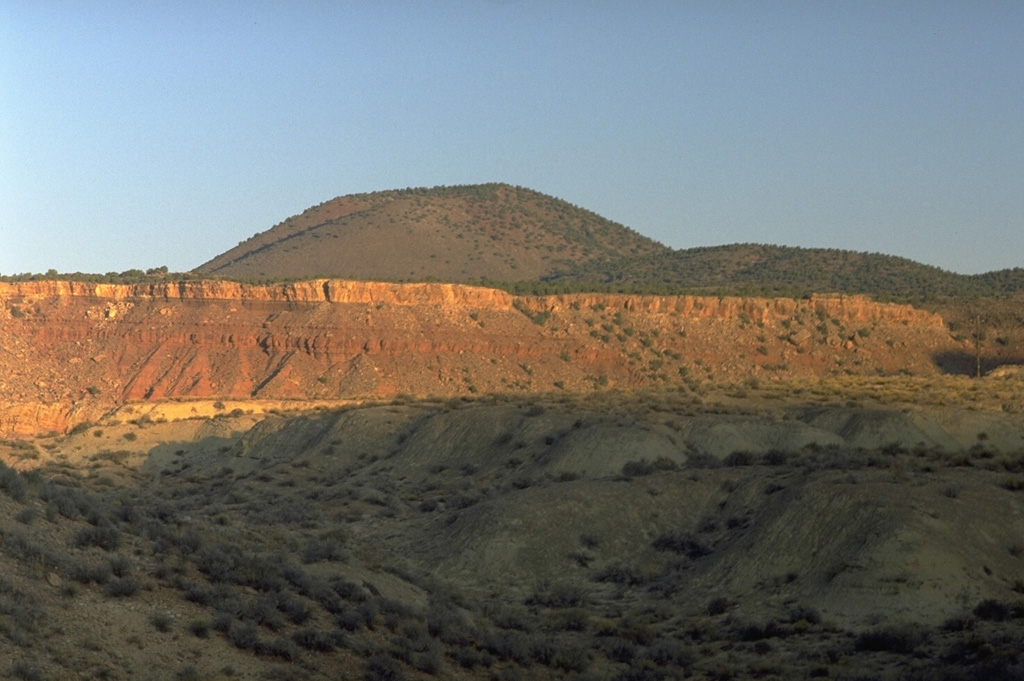
The Global Volcanism Program has no activity reports available for Kolob.
The Global Volcanism Program has no Weekly Reports available for Kolob.
The Global Volcanism Program has no Bulletin Reports available for Kolob.
|
|
||||||||||||||||||
The Global Volcanism Program is not aware of any Holocene eruptions from Kolob. If this volcano has had large eruptions (VEI >= 4) prior to 12,000 years ago, information might be found on the Kolob page in the LaMEVE (Large Magnitude Explosive Volcanic Eruptions) database, a part of the Volcano Global Risk Identification and Analysis Project (VOGRIPA).
This compilation of synonyms and subsidiary features may not be comprehensive. Features are organized into four major categories: Cones, Craters, Domes, and Thermal Features. Synonyms of features appear indented below the primary name. In some cases additional feature type, elevation, or location details are provided.
Cones |
||||
| Feature Name | Feature Type | Elevation | Latitude | Longitude |
| Crater Hill | Pyroclastic cone | 1587 m | 37° 13' 0.00" N | 113° 6' 0.00" W |
| Firepit Knoll | Pyroclastic cone | 2214 m | 37° 20' 0.00" N | 113° 7' 0.00" W |
| Goose Creek Knoll | Pyroclastic cone | 2337 m | 37° 23' 0.00" N | 113° 2' 0.00" W |
| Home Valley Knoll | Pyroclastic cone | 2494 m | 37° 23' 0.00" N | 113° 3' 0.00" W |
| Kolob Peak | Pyroclastic cone | 2727 m | 37° 25' 0.00" N | 113° 4' 0.00" W |
| Spendlove Knoll | Pyroclastic cone | 2102 m | 37° 21' 0.00" N | 113° 6' 0.00" W |
 The morphologically youthful Crater Hill cinder cone near the SW boundary of Zion National Park was formed during the latest eruptions of the Kolob volcanic field at the end of the Pleistocene. Lava flows from Crater Hill blocked the Virgin River, forming an ephemeral lake that extended past the town of Springdale into the national park. Other cinder cones of the Kolob field to the north are of earlier Pleistocene age and fed lava flows extending 10-15 km down valleys to the south.
The morphologically youthful Crater Hill cinder cone near the SW boundary of Zion National Park was formed during the latest eruptions of the Kolob volcanic field at the end of the Pleistocene. Lava flows from Crater Hill blocked the Virgin River, forming an ephemeral lake that extended past the town of Springdale into the national park. Other cinder cones of the Kolob field to the north are of earlier Pleistocene age and fed lava flows extending 10-15 km down valleys to the south.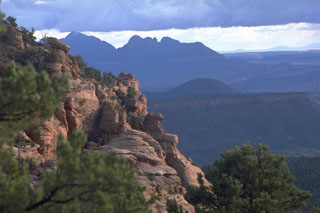 The cinder cone at the right center is Crater Hill, the southernmost and youngest feature of the Kolob volcanic field, a line of cinder cones near the western margin of Zion National Park. Cross-bedded sandstones of the Jurassic-age Navajo Sandstone form the cliffs in the foreground.
The cinder cone at the right center is Crater Hill, the southernmost and youngest feature of the Kolob volcanic field, a line of cinder cones near the western margin of Zion National Park. Cross-bedded sandstones of the Jurassic-age Navajo Sandstone form the cliffs in the foreground.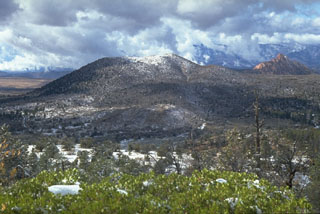 Firepit Knoll cinder cone is the largest of a cluster of cones at the northern end of the Kolob volcanic field on the upper Kolob Plateau. The northern cinder cones, of Pleistocene age, produced lava flows that traveled 10-15 km to the south. The cones were erupted through rocks of the Navajo Sandstone, forming the red-colored pinnacle to the right.
Firepit Knoll cinder cone is the largest of a cluster of cones at the northern end of the Kolob volcanic field on the upper Kolob Plateau. The northern cinder cones, of Pleistocene age, produced lava flows that traveled 10-15 km to the south. The cones were erupted through rocks of the Navajo Sandstone, forming the red-colored pinnacle to the right.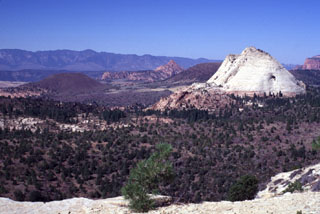 A group of cinder cones of the Kolob volcanic field were constructed on the upper Kolob Plateau in SW Zion National Park. Spendlove Knoll (left) and Firepit Knoll (partially hidden by behind the white sandstone of Pine Valley Peak at the right) are seen here from Northgate Peaks. Lava flows from Firepit Knoll traveled left down Lee Valley to the south. These late-Pleistocene basaltic cinder cones form a dramatic contrast to the colorful rad and white sedimentary rocks of the Navajo Sandstone.
A group of cinder cones of the Kolob volcanic field were constructed on the upper Kolob Plateau in SW Zion National Park. Spendlove Knoll (left) and Firepit Knoll (partially hidden by behind the white sandstone of Pine Valley Peak at the right) are seen here from Northgate Peaks. Lava flows from Firepit Knoll traveled left down Lee Valley to the south. These late-Pleistocene basaltic cinder cones form a dramatic contrast to the colorful rad and white sedimentary rocks of the Navajo Sandstone. 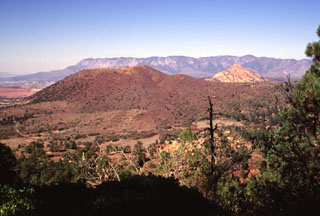 Firepit Knoll (left) is the largest and most well-preserved of a cluster of late-Pleistocene cinder cones on the upper Kolob Plateau in SW Zion National Park. These cones were erupted through sedimentary rocks of the Navajo Sandstone, which forms the light-colored peak of Red Butte at the right. The cinder cones erupted basaltic lava flows that traveled down valleys as far as 10-15 km to the south. The flat-topped summits of the Pine Valley Mountains form the skyline.
Firepit Knoll (left) is the largest and most well-preserved of a cluster of late-Pleistocene cinder cones on the upper Kolob Plateau in SW Zion National Park. These cones were erupted through sedimentary rocks of the Navajo Sandstone, which forms the light-colored peak of Red Butte at the right. The cinder cones erupted basaltic lava flows that traveled down valleys as far as 10-15 km to the south. The flat-topped summits of the Pine Valley Mountains form the skyline.There are no samples for Kolob in the Smithsonian's NMNH Department of Mineral Sciences Rock and Ore collection.
| Copernicus Browser | The Copernicus Browser replaced the Sentinel Hub Playground browser in 2023, to provide access to Earth observation archives from the Copernicus Data Space Ecosystem, the main distribution platform for data from the EU Copernicus missions. |
|
WOVOdat
Single Volcano View Temporal Evolution of Unrest Side by Side Volcanoes |
WOVOdat is a database of volcanic unrest; instrumentally and visually recorded changes in seismicity, ground deformation, gas emission, and other parameters from their normal baselines. It is sponsored by the World Organization of Volcano Observatories (WOVO) and presently hosted at the Earth Observatory of Singapore.
GVMID Data on Volcano Monitoring Infrastructure The Global Volcano Monitoring Infrastructure Database GVMID, is aimed at documenting and improving capabilities of volcano monitoring from the ground and space. GVMID should provide a snapshot and baseline view of the techniques and instrumentation that are in place at various volcanoes, which can be use by volcano observatories as reference to setup new monitoring system or improving networks at a specific volcano. These data will allow identification of what monitoring gaps exist, which can be then targeted by remote sensing infrastructure and future instrument deployments. |
| IRIS seismic stations/networks | Incorporated Research Institutions for Seismology (IRIS) Data Services map showing the location of seismic stations from all available networks (permanent or temporary) within a radius of 0.18° (about 20 km at mid-latitudes) from the given location of Kolob. Users can customize a variety of filters and options in the left panel. Note that if there are no stations are known the map will default to show the entire world with a "No data matched request" error notice. |
| UNAVCO GPS/GNSS stations | Geodetic Data Services map from UNAVCO showing the location of GPS/GNSS stations from all available networks (permanent or temporary) within a radius of 20 km from the given location of Kolob. Users can customize the data search based on station or network names, location, and time window. Requires Adobe Flash Player. |
| Large Eruptions of Kolob | Information about large Quaternary eruptions (VEI >= 4) is cataloged in the Large Magnitude Explosive Volcanic Eruptions (LaMEVE) database of the Volcano Global Risk Identification and Analysis Project (VOGRIPA). |
| EarthChem | EarthChem develops and maintains databases, software, and services that support the preservation, discovery, access and analysis of geochemical data, and facilitate their integration with the broad array of other available earth science parameters. EarthChem is operated by a joint team of disciplinary scientists, data scientists, data managers and information technology developers who are part of the NSF-funded data facility Integrated Earth Data Applications (IEDA). IEDA is a collaborative effort of EarthChem and the Marine Geoscience Data System (MGDS). |